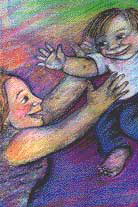THERAPLAY® is an Attachment-Based therapeutic approach using structured play to help children and their families. It has been used effectively since it was first developed in the late 1960s by Ann Jernberg and others at the Theraplay Institute in Chicago. Therplay has been utilized in schools, day care centers, child guidance clinics, speech clinics, and in private practice in the United States, Canada, Australia, Austria, England, Finland, Germany, Japan, South Korea, Sweden, and many other countries. Its primary applications have been with children who have behavior problems (particularly withdrawn and overactive children) speech and language problems, physical challenges, children with Autism Spectrum Disorder, and children experiencing difficulties related to adoption. With the development of Sunshine Circles® in recent years, Theraplay has become a powerful tool to help teachers promote pro-social behavior in the classroom.
THERAPLAY® looks to healthy parent-child interaction as a guide for helping understand children's needs and potentials for positive emotional development. Theraplay sessions are active, intense, physical, nurturing and fun. Parents usually are included in the process from the beginning, and often join in the play sessions later. In school settings, Theraplay can be incorporated in individual and group counseling as well as in typical classroom settings to promote prosocial behavior. Theraplay experiences are structured, nurturing, engaging, and challenging. For professionals as well as clients, Theraplay can be refreshing and rewarding because of its emphasis on engaging, healthy, and constructive social interactions.
THERAPLAY has received the highest rating by the SAMHSA's National Registry of Evidence-based Programs and Practices.
Here are a few resources for those interested in learning more about Theraplay®:
- Bundy-Myrow, S. (2000) Group Theraplay for children with Autism and Pervasive Developmental Disorder. In E. Munns (ed), Theraplay: Innovations in Attachment-Enhancing Play Therapy. Northvale, NJ: Jason Aronson, 301-320
- Tucker, C., Schieffer, L., Willis, T.J., Hull, C., and Q. Murphy (2017) Enhancing social-emotional skills in at-risk preschool students through Theraplay based groups: The Sunshine Circle Model. International Journal of Play Therapy, 26 (4), 185-195
- Booth, P. and Jernberg, A. (2010). Theraplay: Helping Parents and Children Build Better Relationships through Attachment-Based Play (3rd edition) CA: Jossey-Bass
- Siu, A. F. (2014). Effectiveness of Group Theraplay on enhancing social skills among children with developmental disabilities. International Journal of Play Therapy, 23(4), 187
- Bundy-Myrow, S. (2005). Theraplay for children with self-regulation problems. In C. Schaefer, McCormick * A. Ohnogi (Eds.), International Handbook of Play Therapy: Advances in Assessment, Theory, Research, and Practice. (pp. 35-64). New York: Jason Aronson Inc.
- Bundy-Myrow, S. J. (2012) Family Theraplay: Connecting With Children on the Autism Spectrum. In Gallo-Lopez, L. and Rubin, L.C. (Eds.), Play-Based Interventions for Children and Adolescents with Autism Spectrum Disorders. NY: Routledge, 73-96
- Myrow, D.L. (2016) Enjoying Theraplay with school-age children. In A. A. Drewes and C.E. Schaefer (Eds), Play Therapy in Middle Childhood. Washington, DC: American Psychological Association, 115-133
- Jernberg, Ann. (1982). Therapeutic use of sensory motor play. In C. Schaefer, & K, )'Connor (Eds.). Handbook of Play Therapy. NU: John Wiley, 128-147
- Wettig, H. H. G., Coleman, A. R. and Geider, F. G. (2011) Evaluating the effectiveness of Theraplay in treating shy, socially withdrawn children. International Journal of PlayTherapy, 20 (1), 26-37
To learn more about the history of Theraplay, find many more resources and workshops around the world, or find a therapist in many different locations, go to www.theraplay.org

